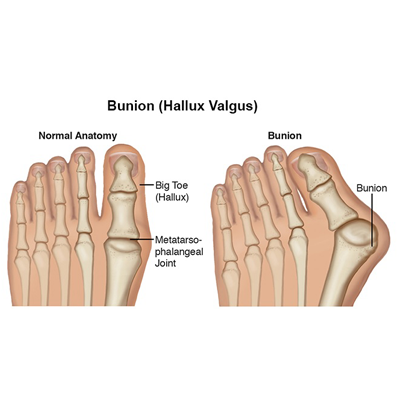Hallux Valgus a.k.a ‘Bunion’

Hallux Valgus (also commonly known as “bunion”) is a progressive disorder of the forefoot in which the bone of the first metatarsophalangeal joint (MTP) (ball of the foot, at the big toe) is bent away from the second toe. This V-shaped misaligned angle of the big toe forms a ‘bump’ on the inner side of the foot, altering the weight distribution across the entire foot. Over time, thickening of the tissues overlying the bony prominence worsen causing pain and may even lead to arthritis. In some cases which are more severe, the first and second toes may overlap
Cause and Risk Factor
The exact cause of this deformity is unclear and could be due to a combination of multiple factors. Hallux Valgus is sometimes inherited as heredity of a faulty mechanical structured foot makes certain foot types more prone in developing a bunion. Wearing narrow, pointed shoes for many years are also more susceptible to develop Hallux Valgus in later years. Other factors may include, poor fitting shoes, flat footed, and chronic Achilles tightness.
Symptoms of a bunion include:
- Bulging bump on the base of the great toe
- Localized pain and tenderness
- Swelling, redness and inflammation around the first MTP joint
- Burning sensation around the first MTP joint
- Callus formation under the first MTP joint
- Altered gait pattern
- Lateral deviation of the first MTP joint.
Diagnosis
Observation is enough to diagnose a bunion, as the bump is obvious on the side of the foot or base of the big toe. However, for better evaluation, a foot and ankle surgeon may order an X-Ray to determine the extent of the deformity of the foot. In cases where the
Treatment
Non-surgical treatment is indicated for initial treatment, this includes:
- Footwear adjustment and Orthotic devices – Opting for shoes which are less narrow and tight and flats with padded cushions over heels
- Activity Modification – Reduce/ Minimize high impact activities and prolong standing duration
- Medication – Oral nonsteroidal anti-inflammatory drugs (NSAIDs) to reduce pain and inflammation.
- Icing – Ice Application several times a day to help reduce inflammation and pain.
- Injection Therapy – Corticosteroids injection in treating the inflamed region
However, if pain persists and is interfering with daily activity, the doctor may recommend Hallux Valgus reconstruction surgery. The aim of the procedure is to realign the affected bones and ligaments to reduce pain and deformity. The recovery length of the recovery period varies depending on the procedure performed.

